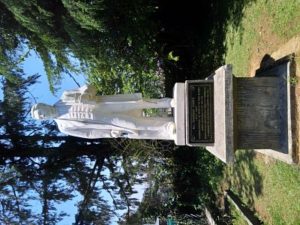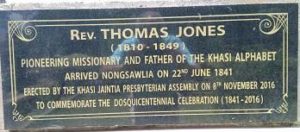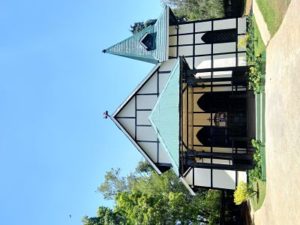 This morning, while walking to the center of town in Shillong, (Khasi Hills, Meghalaya State, India), I chanced upon a statue I had not noticed before. (Not that there are many statues in this town, unlike Russia, Armenia, or other former Soviet republics, where statues abound.) But even without climbing the steps to the front yard of the Presbyterian Church to read the inscription on the base of the pedestal, I had no doubts about whose statue it was.
This morning, while walking to the center of town in Shillong, (Khasi Hills, Meghalaya State, India), I chanced upon a statue I had not noticed before. (Not that there are many statues in this town, unlike Russia, Armenia, or other former Soviet republics, where statues abound.) But even without climbing the steps to the front yard of the Presbyterian Church to read the inscription on the base of the pedestal, I had no doubts about whose statue it was.
Sure enough, it was of Rev. Thomas Jones, a carpenter’s son from distant Wales, who transformed a people in so short a time.
And the reason I had not seen this statue before was that it was erected fairly recently (in 2016) by the Presbyterian Church to commemorate the arrival of Rev. Thomas Jones 175 years earlier. (Dosquicentennial, says the plaque.)
Five months after leaving Liverpool in the winter of 1840, Rev. Thomas Jones and his wife Anne reached Calcutta in April 1841. Soon after, without resting and recuperating from the long voyage, they started for the unexplored Khasi Hills. First, down the Hooghly river, and then via other rivers and lakes to the Surma river in present day Bangladesh, to reach the foot of the Shillong Plateau, before making the steep climb of around 5,000 feet to the village of Nongsawlia, near present-day Sohra (Cherrapunjee), on the 22nd June 1841.
 When I consider the present-day fifty-minute flight from Kolkata to Guwahati, followed by the three-hour uphill drive to Shillong, to be arduous enough, I cannot imagine how strenuous and demanding their tortuous journey must have been through territory that was deadly dangerous at that point in time.
When I consider the present-day fifty-minute flight from Kolkata to Guwahati, followed by the three-hour uphill drive to Shillong, to be arduous enough, I cannot imagine how strenuous and demanding their tortuous journey must have been through territory that was deadly dangerous at that point in time.
But what Thomas Jones did next was, to the say the least, astounding.
By living closely with the people, he not only learned the Khasi language well enough to understand, but also to speak. Then, to the astonishment of everyone, he began preaching to them in their own language!
When he realized that the Bengali script, used till then, was inadequate to represent the full range of sounds of the Khasi language, Thomas Jones set about devising the Khasi alphabet. He used the Latin alphabet as the base, but knocked out ‘C’, ‘F’, ‘Q’, ‘V’, ‘X’, and ‘Z’ found in English, and added the Welsh letter of ‘Ng’. (Subsequently, ‘Ï’, ‘Ñ’ were also added, raising the total of the Khasi alphabets to 23.) He did not rest on his laurels, but wrote the first book, a Khasi primer, and established a mission school at Mawsmai, near Sohra.
 Justifiably, Thomas Jones is revered in the Khasi Hills as the father of the Khasi language and Khasi literature. The 22nd of June, the date of his arrival in 1841 at Sohra (together with his wife Anne) was declared as “Rev. Thomas Jones Day” by the government of Meghalaya.
Justifiably, Thomas Jones is revered in the Khasi Hills as the father of the Khasi language and Khasi literature. The 22nd of June, the date of his arrival in 1841 at Sohra (together with his wife Anne) was declared as “Rev. Thomas Jones Day” by the government of Meghalaya.
Thomas Jones’ life was not without tragedy and drama. His wife, Anne, died in childbirth in 1845 after delivering a son. Two years later, in 1847, he made an ‘injudicious’ second marriage, and was expelled from the mission. His woes did not end there. His conflict with an English entrepreneur made it impossible for him to continue to stay there and he was forced to leave his beloved Sohra.
He caught malaria and died on the 16th September 1849. His tombstone at the Scottish Cemetery in Calcutta reads, ‘The founding father of the Khasi alphabets and literature’.
He was only thirty-nine years old.
How long must a person live to make a difference in this world?


Rachel Beckwith was only nine years old when she died. I think she had a huge impact on many people.
Here is a video: https://youtu.be/nC_vXAF-pBM
Sad and tragic, but inspiring too. Thanks for sharing.
39 years was my answer, when I read the caption of the post, because Swami Vivekananda also lived for exactly 39 years (1863-1902). Zillions of bows to these great performers, not just reformers!
Thanks for sharing. I did not know this. Had somehow assumed that he lived longer.